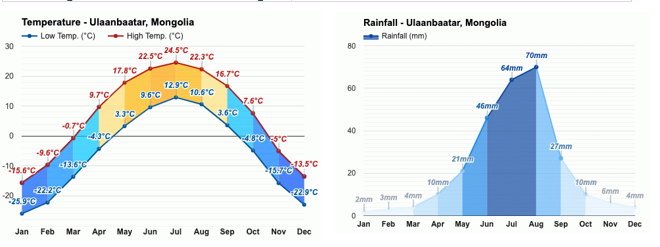
Mongolia experiences a distinctly continental climate characterized by four temperature fluctuations, limited precipitation, and notable regional differences based on latitude and altitude
In most parts of the country, temperatures remain below freezing from November to March and hover around freezing in April and October. January and February commonly see averages of -20°C, with winter nights dropping to -40°C in most years. Summer extremes can reach up to 38°C in the southern Gobi region and 33°C in Ulaanbaatar. More than half of the country is covered by permafrost, presenting challenges for construction, road development, and mining. During winter, all rivers and freshwater lakes freeze, and smaller streams often freeze entirely.
Precipitation is highest in the north, averaging 20 to 35 centimeters per year, and lowest in the south, receiving 10 to 20 centimeters annually. With an average of 257 sunny days per year, Mongolia typically experiences high atmospheric pressure. Ulaanbaatar, situated at an elevation of 1,351 meters in the Tuul Gol river valley, receives an annual average of 31 centimeters of precipitation, concentrated mainly in July and August. The city maintains an average annual temperature of -2.9°C, with a frost-free period extending from mid-June to late August.

Mongolia's weather exhibits extreme variability and short-term unpredictability in the summer, with multi-year averages concealing wide variations in precipitation, frost dates, and occurrences of blizzards and spring dust storms. This unpredictable weather poses challenges to both human and livestock survival. Official statistics indicate that less than 1 percent of the country is arable, 8 to 10 percent is forested, and the remaining land is pasture or desert. Grain cultivation, primarily wheat, occurs in the valleys of the Selenge river system in the north, but yields fluctuate significantly due to unpredictable rain and frost dates.
While winters are generally cold and clear, occasional blizzards, though not depositing much snow, can cover grasses with enough snow and ice to make grazing impossible, resulting in the loss of tens of thousands of livestock. These losses, considered a normal consequence of the climate, can be devastating, particularly to inexperienced herders and entire provinces.
Gobi Desert Region Temperature

The best time to visit Dalanzadgad
Given the extreme winter temperatures, the most favourable time to visit Dalanzadgad, the capital of Southern Gobi province would be from May to September when the weather conditions are relatively mild. Indeed, summer offers the warmest temperatures, reaching highs in the mid-20s°C, and quite comfortable lows from 7°C to 14.8°C. The daylight hours are at their longest during this season, allowing more ample time for exploration. Accompanied by a modest amount of rainfall, the weather can be quite pleasant.

Winter riding in Mongolia

During Summer in Mongolia